Adventure School participates in the Amazon Services LLC Associates Program, an affiliate advertising program for sites to earn advertising fees by advertising and linking to amazon.com
Remove the bike wheel

If you’ve got a flat bike tire, you’ll need to remove your bike wheel. Most modern wheels are attached to the bike with a quick-release (QR) mechanism, but yours may be attached with a bolt-on nut. If you’ve got a QR mechanism, simply flip the lever and unscrew the skewer or thru-axle. The front and rear wheels both come off, but the rear wheel is a bit trickier due to the chain running over the cassette.
Front wheel: Open the QR lever and unscrew the securing nut on the opposite side as needed to release the tension holding the wheel in place. If you have a thru-axle, unscrew and remove the axle.
Rear wheel: Before removing your rear wheel, shift your chain onto the smallest rear cog. To do so, adjust the shifter up then raise your bike and crank the pedals until the gear-shift is complete. It may help to turn the bike upside down or fix it in a bike stand, then turn the rear axle QR lever until it’s fully open. You may need to unscrew the nut slightly on the opposite side. Pull back on your rear derailleur to give yourself some slack, then remove the wheel with your other hand. The wheel should pop free without getting tangled in your chain.
Remove the tire
With the wheel removed, you’re ready to access the tube.
First, you’ll need to get the tire off the rim. Deflate the tube if it’s not already deflated. You don’t need to get all the air out. Just push the tire into the ground with one hand while you hold in the valve stem.


Once you get the tire flat, you can remove one side of the tire to access the tube. You’ll need tire levers for this.
Here are the ones I use. They came in a tool kit like this:
-
 Bike Tool Set$74.98
Bike Tool Set$74.98
Start by unseating the tire from the rim all the way around on one side. Do this by pushing the tire toward the center of the rim. Removing the tire bead from the rim will make it easier to get off.
Next, insert the tire lever between the tire and the rim and push the back of the lever toward the spokes to pop the edge of the tire over the rim.

If the tire is too tight to get it over the rim, use a second lever a few inches away from the first to pry the tire over the rim edge. Some levers come with a notch to hook around a spoke to help keep them in place. Avoid inserting the tire lever near the valve stem to avoid damage to the valve stem.

Then pull the lever around the rim until the entire edge of the tire is out of the rim. Be careful not to snag the tube inside.

You typically don’t have to entirely remove the tire from the rim unless it’s damaged. One side is enough to access your tube.
If you need new tubes, these Schwalbe ones are my favorite kind. They’re the best quality and fit a huge range of tires.
-
 Bike Inner Tubes$16.48
Bike Inner Tubes$16.48
Remove the tube
To find the source of the flat you’ll want to remove the tube entirely from the rim and wheel.
Starting by unscrewing the valve stem and carefully removing the valve, pull the tube out from inside the tire.
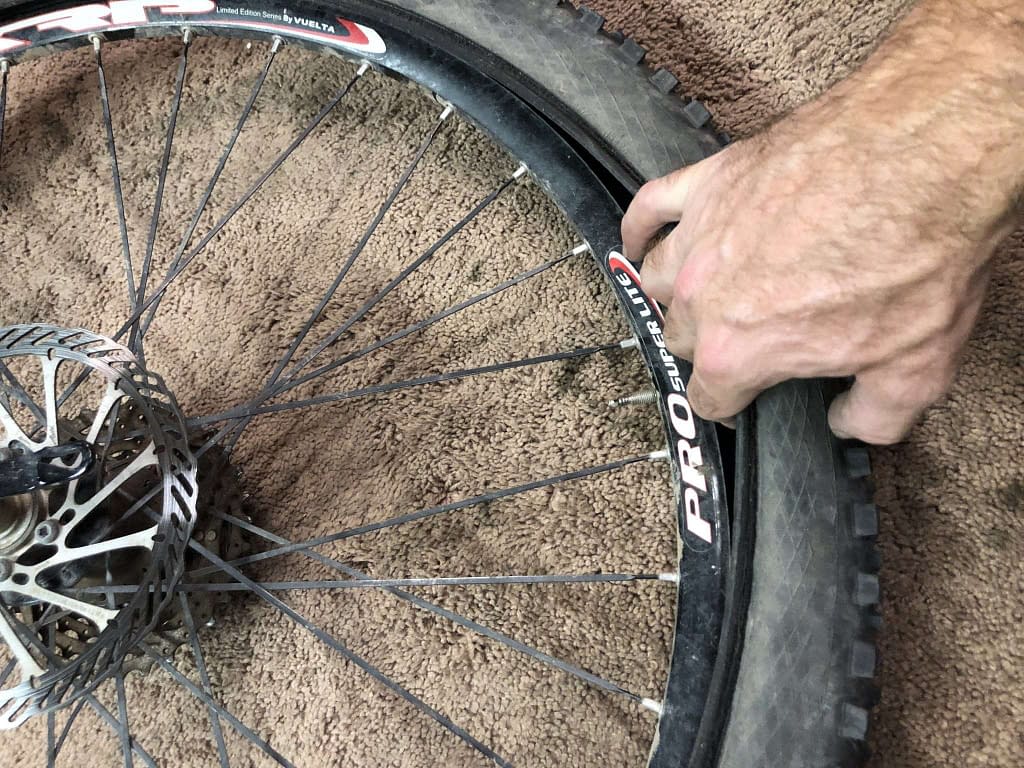
While removing the tube, it’s important to look for the origin of your flat tire. It may be a nail that is now long gone, leaving you with a hole in your tube and tire. Or it may be a thorn or piece of glass that is still stuck in the tire and could damage your newly repaired or replaced tube.
Knowing where the flat bike tire came from will help you know where to look on the tube for damage.
Find the cause of the flat bike tire
Check the rim
With the tube removed, you can look for the source of the flat bike tire.
Check the rim to make sure there isn’t anything sharp that could have caused your flat bike tire. Pay particular attention to the rim tape covering spoke nipples. Sometimes spokes or nipples break and pop through the backside of the rim tape.
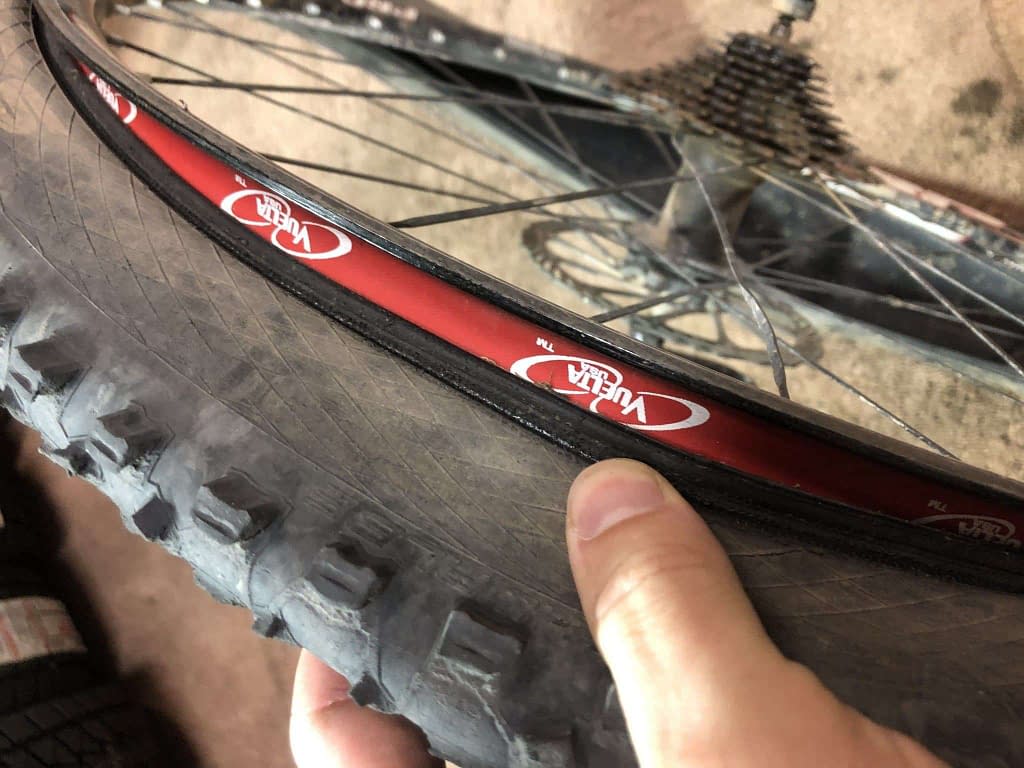
If you see holes in the tape it’s a good indication you have a problem with the spoke you’ll want to investigate. If the rim tape is damaged, you may consider replacing it. The rim strip should be wide enough to cover the bottom of the rim, but not so wide it interferes with the seating of the tire bead.
-
 Rim Tape$11.99
Rim Tape$11.99
Here’s the rim tape I’ve used with good success. It’s especially good if you’re planning to run tubeless.
Check the tire
When searching for the cause of a flat, begin on the outside and work your way in. Check the outer surface of the tire for any signs of damage or wear. Look for foreign objects in the tread, cuts or tears in the tread or tire sidewall, or worn/cracked tread patterns.
Also, check inside the tire for similar issues.
Run your hand through the inside of the tire to check for thorns, glass, rocks, or other sharp objects. If something causes you to bleed there’s a good chance it put a hole in your tube. If you put a new tube in or patch your old one without removing the source of the puncture, you’ll be practicing a lot of flat bike tire repair.
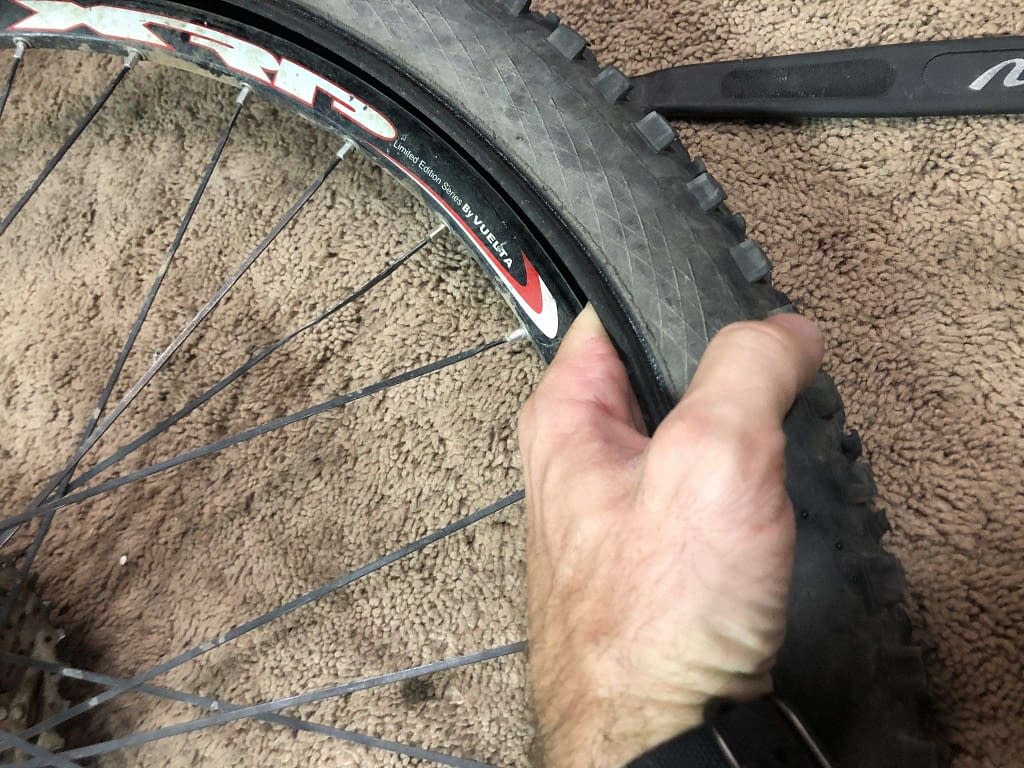
You may not find anything in the tire or rim that would cause a puncture. Sometimes things go through your tire and tube and don’t stick,` or sometimes other sources cause the damage.
Check the tube
Tube damage can be difficult to spot. If you don’t see any obvious punctures or blowouts, try inflating the tube so you can check for escaping air. Overinflating the tube will make it easier to find pinhole leaks.

To find very small leaks, pass the tube close to your lips or ear to feel for air or submerge it in water and look for bubbles. Start at the valve stem and work your way around the entire tube.
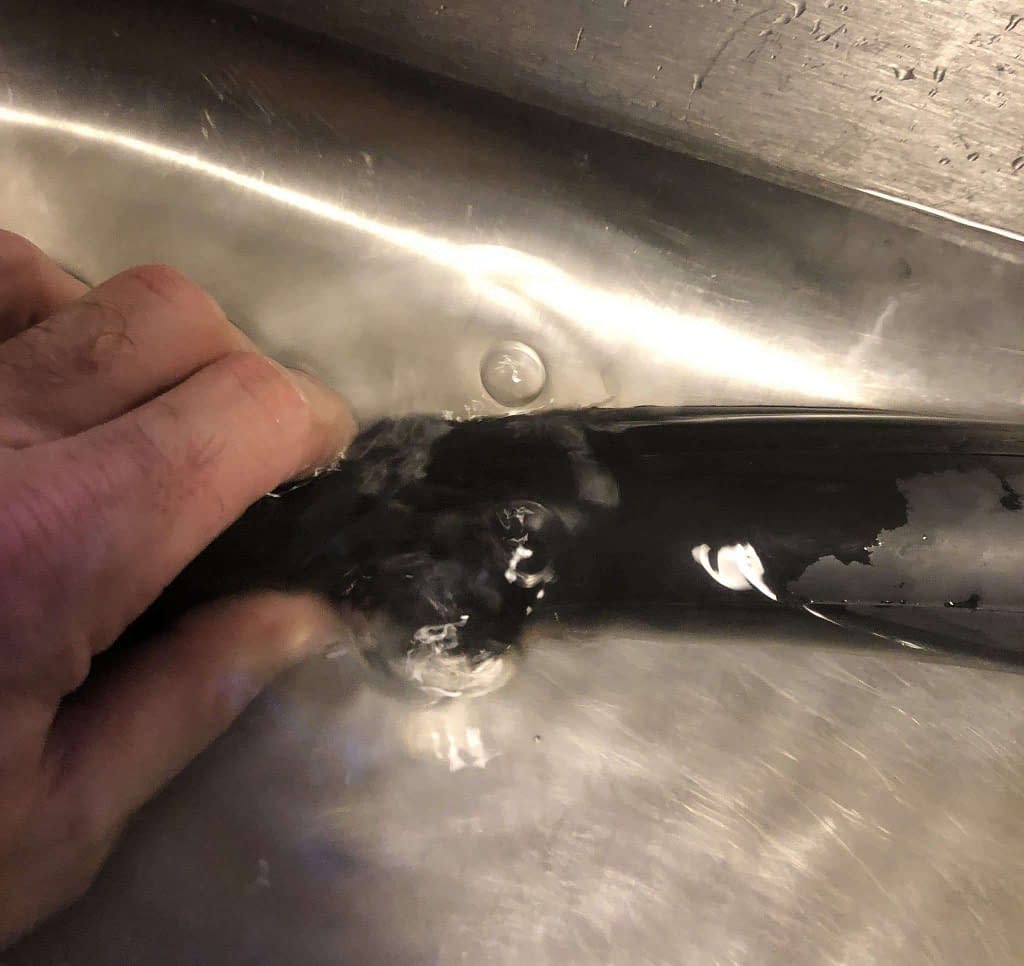
If you can’t find any tube damage, check the valve. If the valve stem or base is cut, cracked or severely worn, it may be leaking. The entire tube will need to be replaced if you find a damaged valve stem. Sometimes the flat bike tire is as simple as a loose or faulty valve.

Once the tube damage has been found, check your tire for damage at the location of the puncture. Use the valve stem to align the tube so you can find the same location on the tire. Look for any embedded objects again.
Finding the root cause of the puncture is important in preventing it from happening again.
If you plan to repair the inner tube, use a marking pen to mark the hole. I use a silver sharpie so it’s easy to see. Don’t mark too close to hole, as the mark may be sanded off. The type of cut or hole in the tube will help determine the cause of the flat.
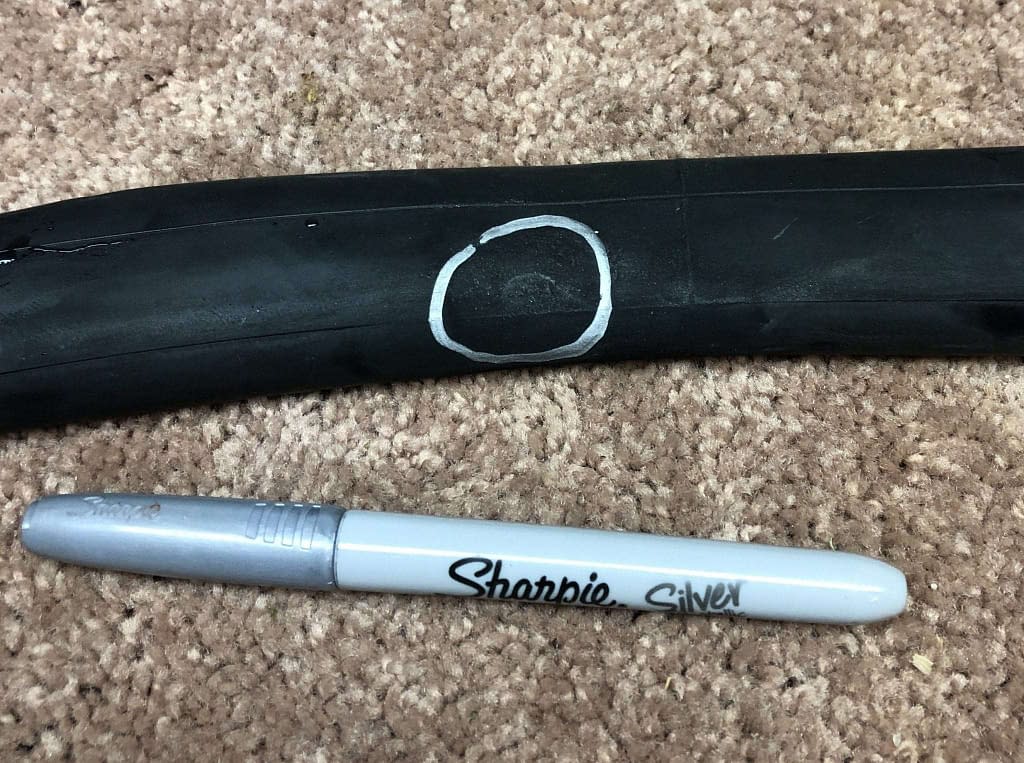
Common causes of tire and tube failures:
- A single puncture or small hole is commonly from a thorn, wire, or small nail. These may be repairable.
- Double slits are commonly the result of a rim pinch. These are also called snakebites. They can also happen to only one side of the tube. The root cause here is that the tube was underinflated for the type of riding. Adding more tire pressure or changing the tire and/or rim size will prevent this in the future.
- A complete blowout causing a large shredded hole is usually not repairable. Check the tire and rim as well for damage. These can be caused by overinflation or old tubes.
- A long cut or rip may also indicate a tire blowout. Typically this is not repairable. these can result when the tube gets trapped between the rim and tire on installation.
- A hole in the rim side of the tube indicates a problem inside the rim, such as from rim strip failure, a protruding spoke, or other sharp objects inside the rim.
- A cut at the valve core can result from misalignment of the tube in the rim. This is more common with Schrader valves that don’t have valve stem nuts. Riding with low pressure can also cause the tube to rotate inside the wheel. Be sure the tube is mounted straight in the rim and check your tire pressure before rides.
- A leaky valve core can be a hard-to-find leak. Tighten with a valve core tool such as the VC-1. These leaks are more common with Schrader-type valves, but also happen with Presta valves on occasion.
Repair or replace the tube
Repairing your tube
If your tube only has a small puncture hole or two, you can repair it with a simple patch job. If it’s severely ripped or blown out, you should replace it. Most commercial flat bike tire patching kits contain everything you need to create an effective patch in the field. Knowing how to get a solid patch with the tools is something you should know before you need it in the field.
Here’s a patch kit I carry with me in case I need to do a quick field job. I also have a kit at home for all the flat bike tires my kids bring home on their bikes.
-
 Vulcanizing Patch Kit$9.90
Vulcanizing Patch Kit$9.90
You already identified the location of the flat bike tire and should have marked it so you don’t lose it again.
Clean and dry the damaged area if it’s dirty or oily at all.
Use the sandpaper or abrasive strip in your patch kit to rough up the surface around the damaged area. This helps create a better bond between the patch and the tube.
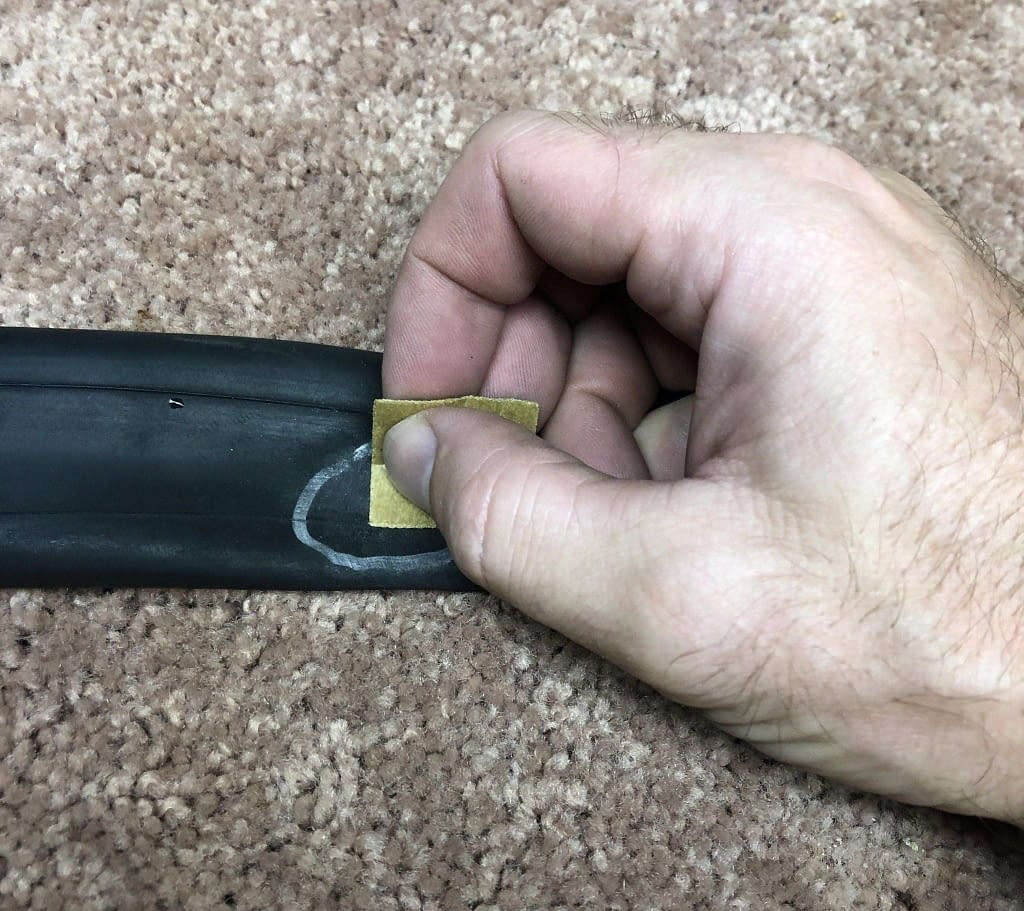
Spread a thin film of vulcanizing fluid in a small circle around the hole about the size of the patch you’re using – typically about the size of a quarter.

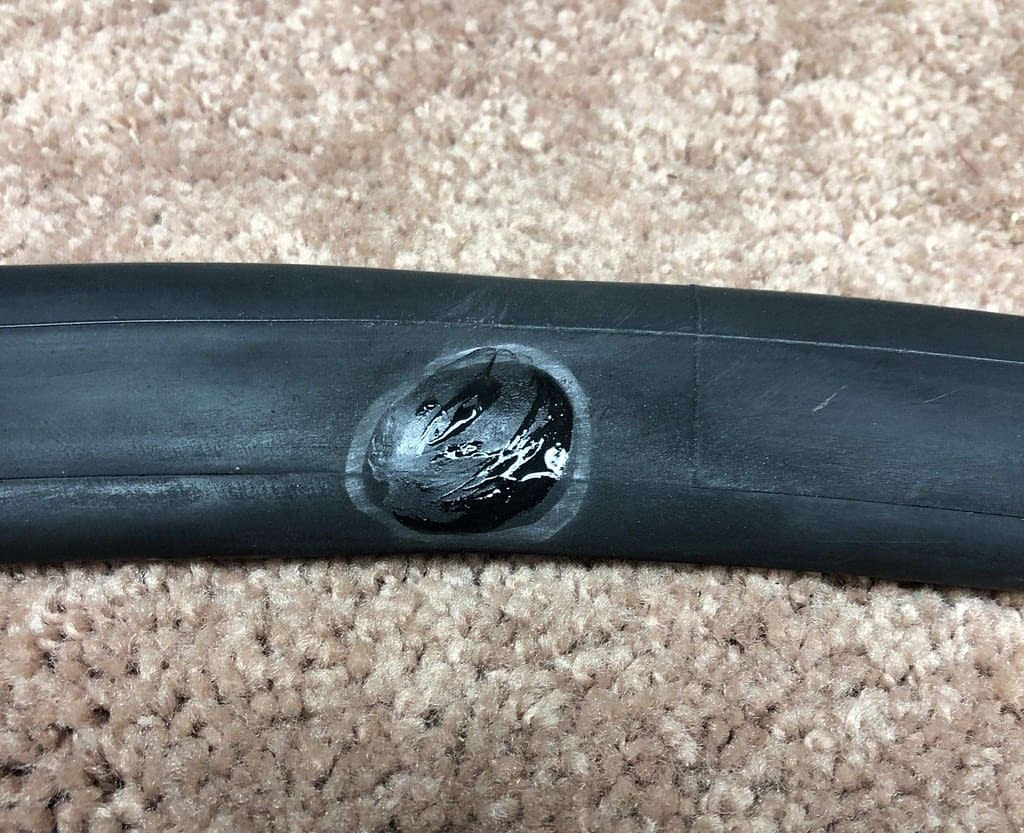
Peel the foil or plastic film off the back of the patch and apply it to the spot of glue. Hold the patch in place with firm pressure until the glue dries.
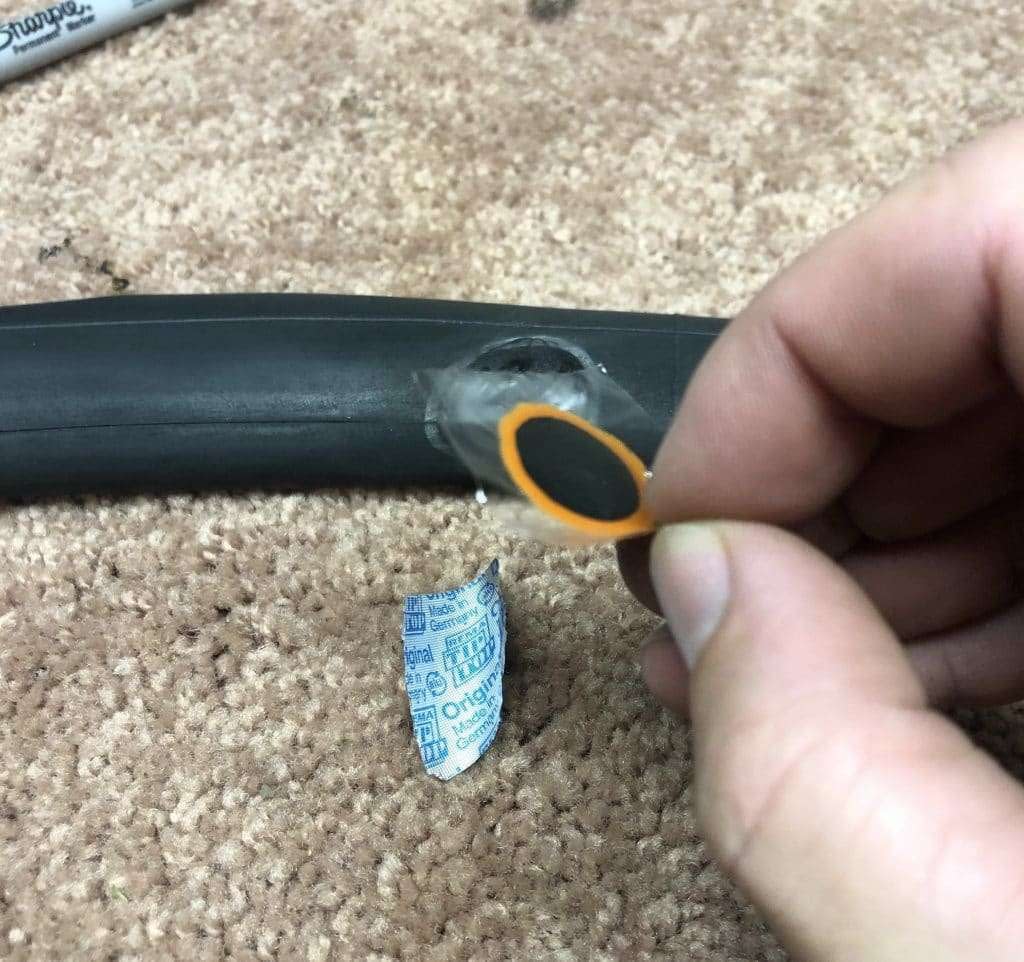
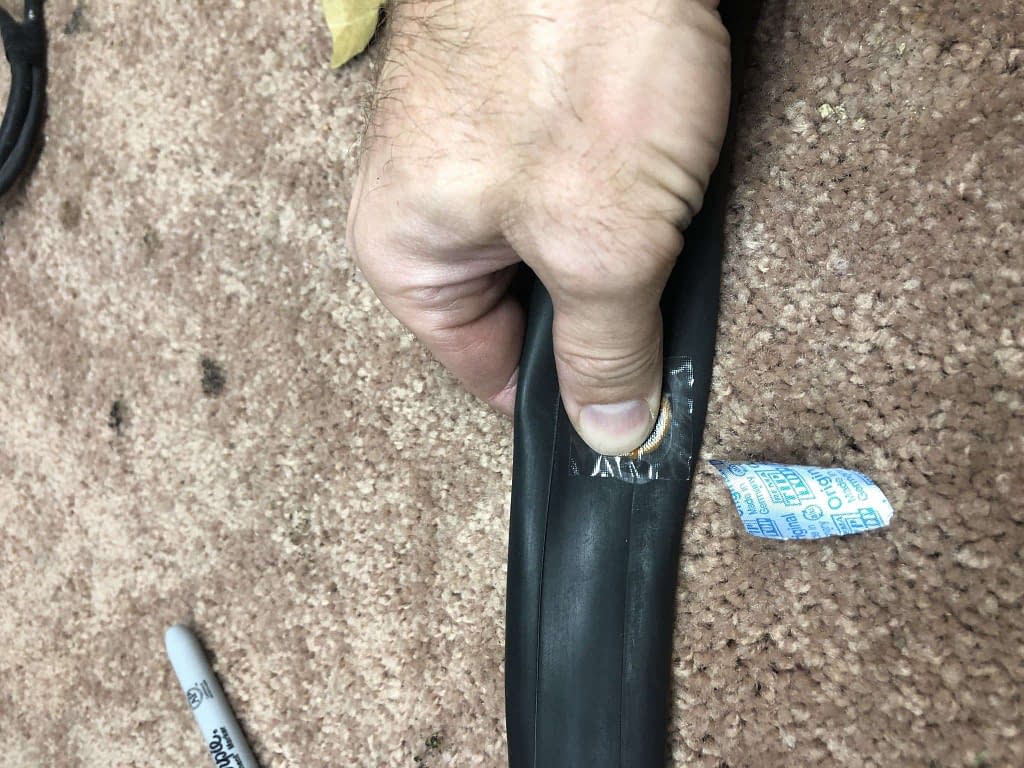
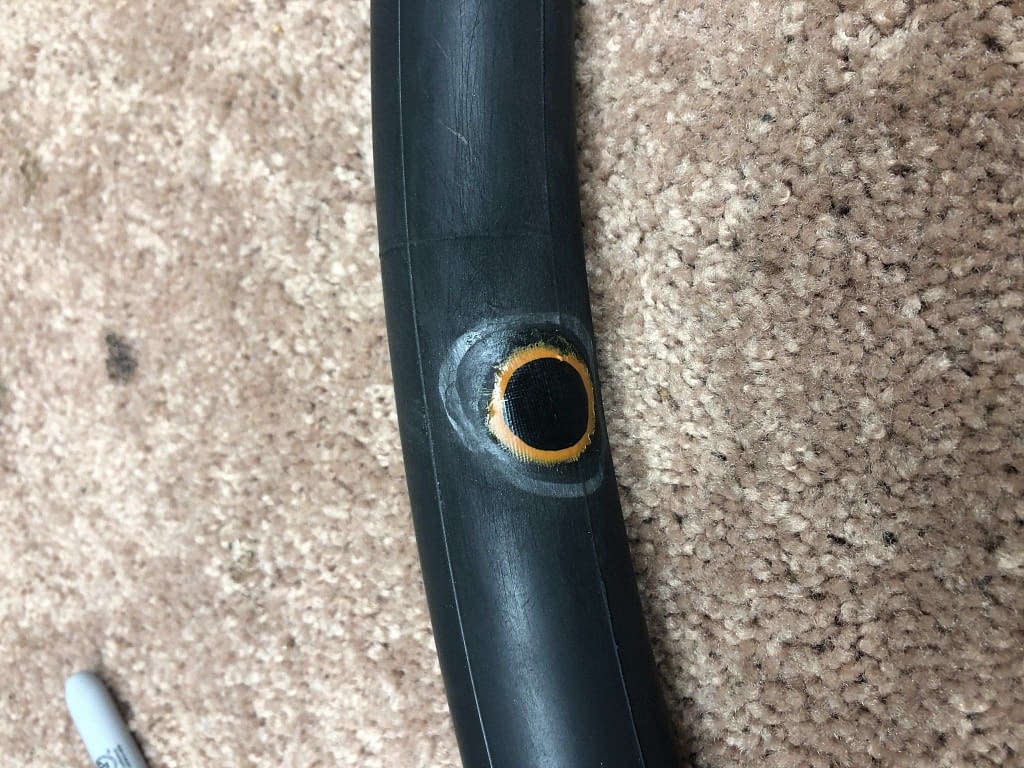
Replacing your tube
If the flat bike tire is too bad to repair or the valve stem is damaged, you’ll need to replace your tube. This is simply a matter of buying a new tube of the right size and installing it in the rim.
Reinstall the tube
To install a new tube or repaired tube, you’ll first want to ensure the rim strip is properly positioned.
It helps to partially inflate your tube to give it some shape and keep it inside the tire and rim.
Using a good floor pump or a reliable hand pump can make this job easy. Here are the ones I’m loving right now.
Find the valve stem hole in the rim and insert the valve stem into the hole. Ensure the valve stem is seated straight through the hole and not angled at all. If you have a valve stem nut, you can install it now.
Next, insert the rest of the tube into the tire.
Reinstall the tire
Once the tube is in the tire, you can start placing the tire back onto the rim. Do this by pushing the bead over the edge of the rim. As you move around the wheel this will get increasingly hard. At this point, you have to be mindful that the tube doesn’t get pinched between the tire bead and the rim or you’ll be doing the repair job all over again soon.

Get the tire onto the rim as much as you can with your hands and then reach for those tire levers again. Using your tire levers, carefully insert one into the tire and turn it down so the end dips into the rim being careful not to pinch or snag the tube. You can slide the lever along the rim and you may be able to get the whole tire seated. More than likely you’ll need the second lever to hold one section of the tire in place in the rim while you work toward it with the other lever.
Once the tire is on the rim, check the whole circumference to ensure the tube isn’t pinched at all. This can be accomplished best if you deflate the tube again and then reinflate it partially then circle the wheel pushing in on the base of both sides of the rim to entirely separate the tube from the rim.
Once you’re sure the tube is properly installed, you can inflate the tube to the proper riding pressure.
To learn how to properly set your tire pressure check out this post: Tire pressure guide for mountain bikes
Reinstalling the Bike Wheel
If you took the tire entirely off the rim, you’ll need to ensure you install it in the right direction. Check for directional arrows on the tire sidewall. If you see one, that’s the direction the tire should rotate when installed. Many tires don’t have directions so if you don’t see an arrow, no worries.
Rear Wheel
With the bike in its normal, upright position, position the wheel so the top section of the chain sits over the smallest cog in your cassette. Line up the dropouts on the bike frame with the axle. While lowering the bike into place, pull the derailleur down and back to get it out of the way and reduce resistance. Push down gently on the saddle and make sure the axle is securely seated in the dropouts. If the wheel doesn’t slide in easily, remove it and try again.
If you have disc brakes, you’ll also need to keep an eye on the rotor to ensure it slides between the brake pads.
Hold the QR lever in place and tighten the bolt on the drive side of the bike. Once the bolt is tight, close the lever. Make sure it’s tucked out of the way, pointing up or back, and not touching the bike’s frame. If the lever closes too easily and is touching the frame, it’s probably not tight enough. Open the lever and tighten the bolt some more.
If your bike has caliper or cantilever brakes, remember to reconnect them and make sure they’re working.
Finish by spinning the pedals and making sure the gears shift normally. If the wheel didn’t get aligned in the frame properly, the brakes will rub.
Front Wheel
Line up the dropouts in the fork with the axle of the front wheel and slowly lower the fork onto the axle. Push down gently on the handlebar to make sure the axle is seated in the dropouts.
Hold the QR lever in place as you tighten the bolt. When the bolt is tight, close the lever. Make sure it’s facing up or back, out of the way, and not touching the fork. If the lever closes too easily and is touching the fork, open the lever and tighten the bolt some more.
Reconnect the brakes and make sure they’re working.
If you’re looking for more on how to fix a flat, let us know in the comments and we’ll get you any info you need. You can also check out these resources:
https://www.realsimple.com/work-life/family/how-fix-flat-bike-tire
https://www.youtube.com/watch?v=58STtUM-Wow
Conclusion
Flat tires suck! Preventing flat bike tires is the best option, but flats happen even to the best of us. Having the tools and knowledge to repair a flat bike tire in a pinch will go a long way to helping you enjoy your rides.






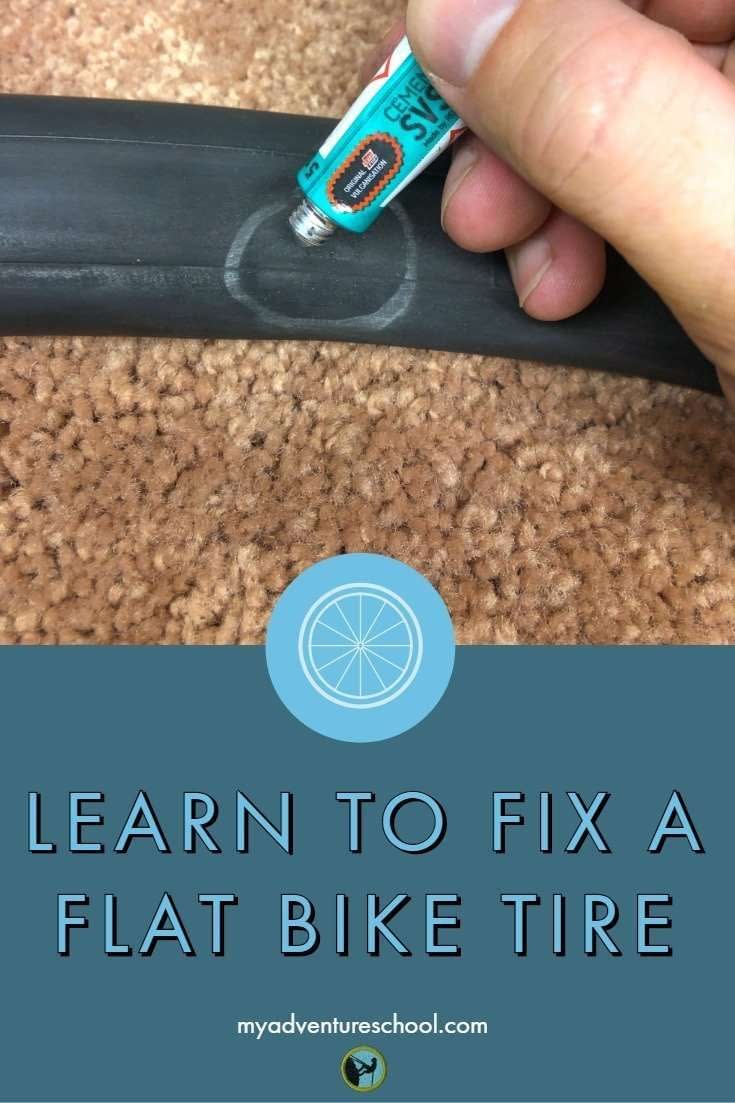



Steps to fix a flat bike tire without tools: a useful guide you should know: The first step to fixing a tool-free bicycle tire is to separate the tire from the bicycle wheel. When you repair a flat bike tire, it is crucial to remove the tire bead by crouching down and placing the wheel in front of your knees. You have to pull the tire together with the tube towards the direction of your body. Apply pressure to your thumbs that are placed on the rim, so you can easily pull the tire from it. Then, inflate it by opening the Presta valve and blowing air into the tube until you are confident there’s enough air inside. Ensure that the tube is in the right shape so you can put it back into the tire easily.
Thanks Dalton, I’ve rarely been able to remove and repair my tires without tools, but it may work on some tire/rim combos.
Patching a flat tire without tools can help you deal with a flat tire situation, especially in situations where you don’t have a tool to lean on.
Thanks Dalton. Fixing a flat bike tire without tools is a bit more challenging for sure.